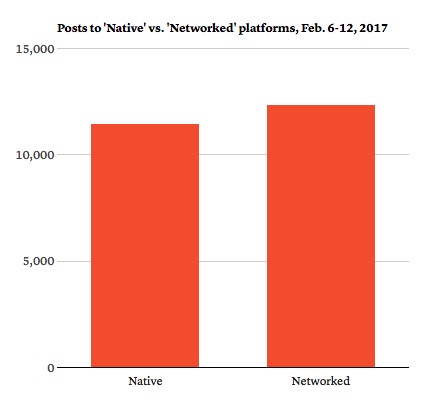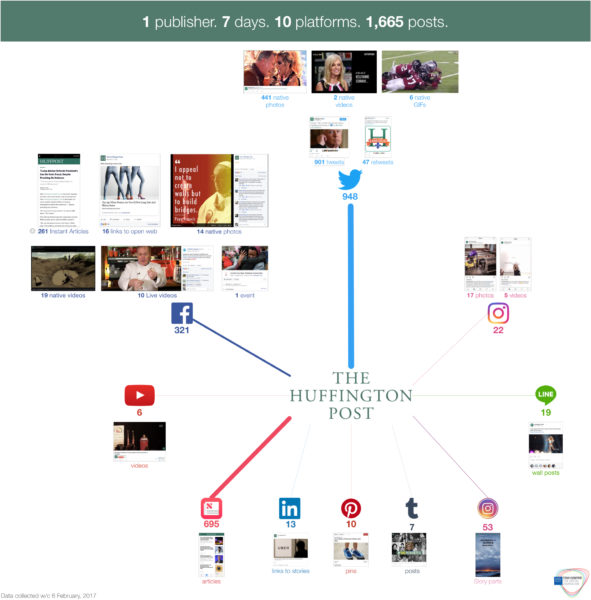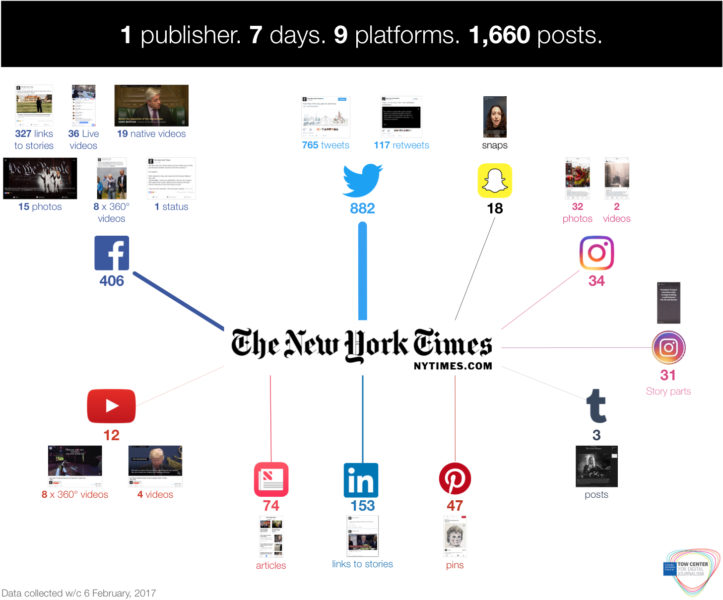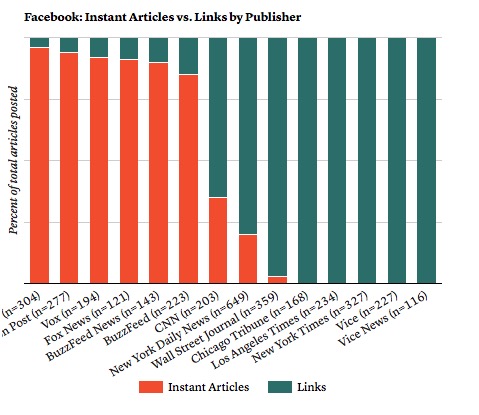Publishing used to be relatively simple. You published a newspaper once a day or produced a nightly newscast. Even with the advent of the Internet things were fairly straightforward: You had a website and posted your coverage there. But as platforms — from Facebook and Snapchat to messaging platforms such as Kik and Line — become more ubiquitous, news organizations now have to decide where they want to publish and how they want to present their coverage on these platforms.
A study out this week from the Tow Center for Digital Journalism at Columbia University examines how platforms have changed journalism, and while the entire 25,455-word report is worth reading, one particularly interesting section looks at how news outlets are choosing to publish (or not publish) across a variety of platforms.
The report compares how The New York Times, CNN, and The Huffington Post utilized platforms during a week in early February. In that span, each outlet posted to about 10 different platforms. The Times and HuffPo each posted about 1,660 times across the various platforms. CNN, however, published more than 2,800 stories, about 40 percent more than the other two.
The Tow report defines two primary different types of platform-based content: native and networked. Native content includes entities such as Snapchat Discover and Stories, Facebook Instant Articles, or Apple News. These formats live entirely within the walled gardens of the platforms. Networked content, meanwhile, links back to the news organizations’ own sites.
The study examined 14 publishers and found that during the week of Feb. 6, they posted 12,341 pieces of networked content and 11,481 pieces of native content.

“While publishers all need to have a presence across a broad range of platforms, how they distribute their content — and, in particular, the amount they ‘give away’ to platforms in the form of native content — differs considerably,” the study said.
During the week of February 6, two-thirds of The Huffington Post’s distributed content was posted in native formats. That includes 695 stories on Apple News and 305 Facebook posts, which include Instant Articles, Live Video, and other formats. “These native Facebook posts also represent 98 percent of Huffington Post’s total Facebook posts,” the study found.

CNN similarly posted 59 percent of its content natively. That included 1,016 Apple News Articles, 948 tweets, and 278 YouTube videos. The report also noted that “CNN’s concerted effort to reach younger audiences is also evident in its Snapchat Discover channel, on which we saw a shift away from scrollable articles repurposed from cnn.com to more bitesize news cards, and its ongoing commitment to chat app LINE.”

Meanwhile, only 16 percent of the Times’ posts were native. The Times was one of a handful of news organizations that Facebook launched Instant Articles with in 2015, but the paper has since stopped publishing on Instant Articles. During the week that Tow measured the posts, just 19 percent of the Times’ 406 Facebook posts were native to the platform. The paper also posted 74 stories on Apple News.

Unlike The Huffington Post and CNN, the Times is focused on digital subscriptions and its main goal is to drive users back to its own platforms, which explains its reluctance to use native posts.
In a speech at a conference last year, Lydia Polgreen, who was then the editorial director of the Times’ global expansion effort and is now the editor of The Huffington Post, explained how the Times’ approach to platforms is different than other publishers.
Social platforms, especially Facebook, allow us to target our journalism to those most likely to want to pay for it. I believe that we are better off as Facebook’s happy customer than as its outgunned competitor in a David and Goliath fight for advertising dollars.
Yes, Facebook will try mightily to keep news consumers inside its platforms, via features like Instant Articles. Our job is to create experiences that will draw our most loyal users back, again and again, to our own products. So far, we seem to be succeeding at this. We will never be as big or financially successful as Facebook, but I believe we can run a thriving media company that can afford a lavishly funded news operation, as well as return value to our shareholders.
Many of the people the study’s authors — Emily Bell and Taylor Owen — interviewed reiterated that business models often determine how news organizations approach publishing on the platforms:
Jim Brady, founder and CEO of Billy Penn, a Philadelphia mobile news platform, said that when it came to Instant Articles, “I can afford to be a little bit more agnostic about it than someone whose revenue is tied to where the page view lies.” Gabe Dance, former managing editor of the not-for-profit news organization the Marshall Project said their resources were focused on “impact” because that’s what funders care about. And, after an unsuccessful experiment with NPR to host audio natively on the platform, Wright Bryan, senior editor for engagement, walked away wondering, “Does audio really fit a format like Facebook?”
One example of this is that the study showed that publishers’ attitudes toward Instant Articles in particular varied greatly. Outlets such as The Washington Post, Vox, and BuzzFeed News all posted more than 90 percent of their links as Instant Articles during the week of February 6. Meanwhile, Vice, Vice News, and Tronc papers the Chicago Tribune and the Los Angeles Times aren’t using Instant Articles at all.

“I think because there’s a continuous debate as to the very question: ‘What do you need to control, and what things do you not,’” Sterling Proffer, head of business strategy and development at Vice, told the study’s authors. “Going all in, solely on the platform to support your entire ecosystem in every way, is a big gamble.”